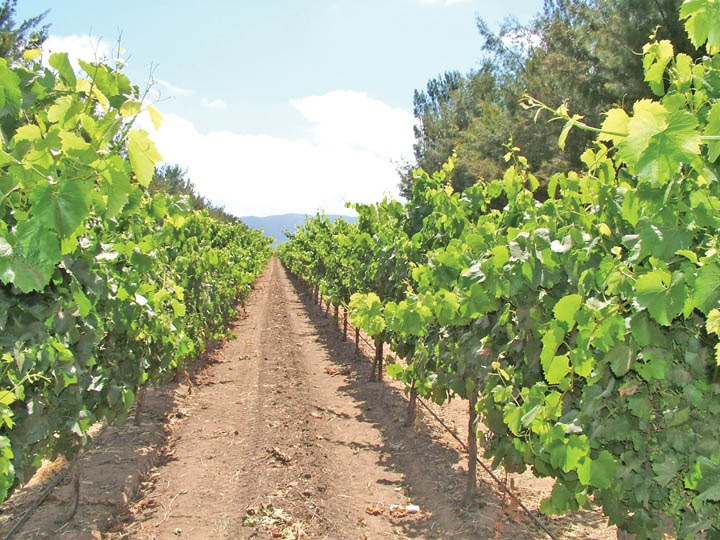
Leafhoppers can pose a threat to many California vineyards. Both nymphs and adults suck up the contents of leaf cells, leaving behind empty cells that appear as pale yellow spots or stippling. Under high feeding pressure, the entire leaf may be pale yellow or white.
Vines can tolerate fairly high populations without harm, report University of California Cooperative Extension researchers. Also, predators and parasites may be able to keep leafhopper numbers in check.
However, severe infestations can lead to leaf drop, resulting in sunburned fruit and even delayed ripening of the grapes, especially in young vines. In young or stressed vines, this can reduce shoot growth the following season.
The grape leafhopper is a pest of grapes in the San Joaquin, Sacramento, and North Coast valleys, as well as in the warmer, interior Central Coastal valleys. The variegated leafhopper is the major pest of grapes in southern California and in the Central Valley as far north as San Joaquin County.
UCCE farm advisors and IPM specialists offer the following tips for managing this pest.
Biological Control
Natural enemies that can help control leafhopper include egg parasites, particularly such as Anagrus epos and other Anagrus spp., which are commonly found in vineyards during part of the season. Anagrus spp. is more effective on the eggs of the grape leafhopper than the variegated leafhopper. General predators of grape leafhoppers include spiders, green lacewings (Chrysopa spp.), minute pirate bugs (Orius spp.), lady beetles (Hippodamia spp.), and predaceous mites.
Cultural Control
Removing basal leaves or lateral shoots during berry set and the following two weeks (before adult leafhoppers emerge) will normally reduce peak leafhopper populations during the season by 30 percent to 50 percent. This plus Anagrus activity may eliminate the need for insecticide treatment, even when leafhoppers exceed thresholds. Also, leaf removal will improve pesticide coverage and effectiveness.
If the vineyard is accessible before budbreak and erosion is not a risk, remove weeds in vineyards and surrounding areas before vines start to grow in spring to reduce adult leafhopper populations that might disperse to new grape foliage.
Organically Acceptable Methods
Biological and cultural control methods, including basal leaf removal, help with control. When nymphs are small, narrow range oils, insecticidal soaps, or kaolin clay may give partial control. Soaps may spot table grapes and should only be used before bloom on this crop.
Treatment Thresholds
A level of 10 percent to 30 percent parasitism on eggs of the first generation may result in economic control of the grape leafhopper during the second and third generations. However, that’s less likely if the variegated leafhopper makes up most of the leafhopper population. However, a combination of parasite and predator activity can be effective.
Wine and Raisin Thompson Seedless Grapes
For the first generation, treatment is not necessary if there are 20 or fewer nymphs per leaf. If Anagrus is active on eggs of the first generation, it is best wait until leafhopper numbers are well above 20 per leaf before treating. If treatment is needed, wait until more than half the nymphs are in the third instar. This allows enough time for most eggs to have hatched.
For the second or third generation on wine and raisin Thompson Seedless grapes, the treatment threshold is 15 to 20 nymphs per leaf. Usually, lower populations do not need treatment. However, coastal wine grapes with a low incidence of parasitism and small canopies may have a threshold of 10 to 20 nymphs per leaf. Vigorously growing vines can support higher populations.
Table Grapes
The treatment level is lower for table grapes, since they need better fruit protection. For the first generation, treat if more than 15 leafhopper nymphs per leaf are found. In the second and third generations, early varieties (Flame Seedless) should not exceed 10 nymphs per leaf; midseason varieties (Thompson) 5 to 10 nymphs per leaf; and late varieties (Emperor) 5 to 8 nymphs per leaf.
Because large populations of adult leafhoppers in the fall are very annoying to workers who are hand harvesting grapes, a treatment just before harvest may be warranted.
More information on managing leafhoppers, including selection and use of pesticides, is available at www.ipm.ucdavis.edu.
Want the latest agricultural news each day? Click here for the Western Farm Press Daily e-mail newsletter.
About the Author(s)
You May Also Like




